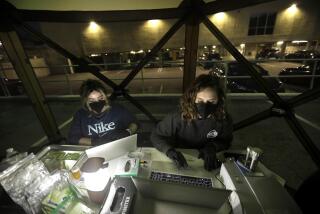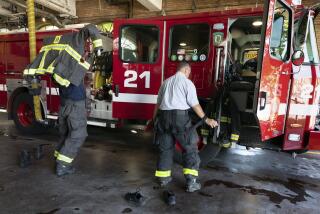McVeigh’s Clothes Had Residue of Explosives, FBI Expert Says
DENVER — A supervisor in the FBI crime laboratory identified traces of explosive chemical residue on pieces of clothing worn by Timothy J. McVeigh when he was arrested in the Oklahoma City bombing.
Steven Burmeister, acting chief of the lab’s chemistry / toxicology unit, said that similar residue was found on a set of earplugs carried by McVeigh and on a small panel recovered from what was left of a Ryder rental truck allegedly used to carry the bomb to the front of the Alfred P. Murrah Federal Building. The April 19, 1995, blast killed 168 people and injured 500 more.
The testimony by Burmeister marked the first time that forensic examinations performed by FBI agents were introduced as evidence. Government prosecutors hope to use the testimony to show that McVeigh helped mix ammonium nitrate and fuel oil into barrels to make the bomb in the back of the truck.
But the evidence could also help the defense. McVeigh’s lawyers are planning to attack work done at the FBI crime lab. They will be bolstered by the recent scathing Justice Department report that verified widespread contamination and procedural problems at the once-vaunted FBI laboratory.
Burmeister said that he examined items taken from McVeigh’s jeans pockets, including a set of earplugs that prosecutors contend McVeigh used to deaden the roar of the blast. “A general testing showed they all were positive” for traces of chemical components, he said.
Tests on the right pocket revealed traces of nitroglycerin and PETN, a highly explosive material, he said, and the left pocket had traces of nitroglycerin and other debris “consistent with PETN.”
Burmeister said that his examinations of the two T-shirts McVeigh was wearing also revealed a “positive finding” for chemical residue.
He said that he found the piece of truck panel “had definitely gone through some severe damage.” He added: “There was a portion that had a covering of white crystals. Under the microscope, it looked like table salt.”
When tested, the crystals “indicated a strong oxidizer like ammonium nitrate,” he said.
Pressed about his conclusion, Burmeister said there is “no doubt whatsoever” that the crystals were ammonium nitrate.
Burmeister also said it was impossible that any of the evidence could have been improperly contaminated by exposure to other chemicals, either during shipment to the lab in Washington or at the lab itself. “There really is no way contamination could have come into play,” he said.
If McVeigh is convicted, he could be sentenced to death. He has pleaded not guilty.
Burmeister explained for the jury what occurs in an ammonium nitrate and fuel oil blast, saying that the bomb explodes at a speed of about 9,000 feet per second.
It covers the immediate area with chemical debris, he said, and objects like street signs serve as “catcher mitts” in collecting chemical components.
He testified that certain ammonium nitrate and fuel oil bombs are more effective than others, depending on whether they are assembled into “shape charges” before detonation.
Earlier in the trial, McVeigh’s friend Lori Fortier testified that the defendant had boasted to her that he planned to build a truck bomb with a “shape charge” by lining the ammonium nitrate barrels in a triangle formation. He bragged that this would cause more destruction to the Murrah building, she said.
More to Read
Sign up for Essential California
The most important California stories and recommendations in your inbox every morning.
You may occasionally receive promotional content from the Los Angeles Times.











